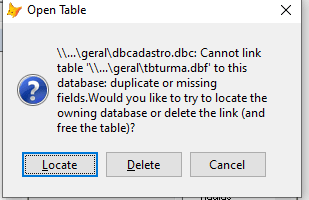ROGERIORIOS
Programmer
I was changing the structure of a table in the database and forgot it was open in a query.
There was an error in the VFP , it crashed and closed.
Afterwards I received the message that "field did not match".
I removed the table from the database, renamed it and got it from my backup.
I didn't include it in the database, I just tried to open it and VFP says the "dataini" field doesn't exist.
I'm not understanding the reason for this message as if the VFP was treating the copy of the table as the corrupted table
There was an error in the VFP , it crashed and closed.
Afterwards I received the message that "field did not match".
I removed the table from the database, renamed it and got it from my backup.
I didn't include it in the database, I just tried to open it and VFP says the "dataini" field doesn't exist.
I'm not understanding the reason for this message as if the VFP was treating the copy of the table as the corrupted table

